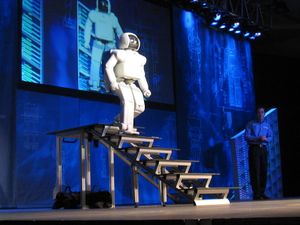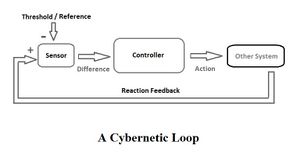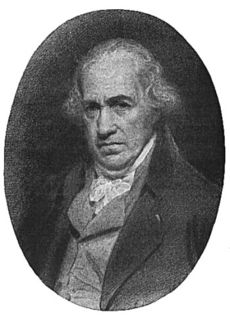控制论
Cybernetics is a transdisciplinary[1] approach for exploring regulatory systems—their structures, constraints, and possibilities. Norbert Wiener defined cybernetics in 1948 as "the scientific study of control and communication in the animal and the machine".[2]
控制论 Cybernetics是探索调节系统的跨学科研究[1],用于研究控制系统的结构、局限和发展。诺伯特·维纳 Norbert Wiener在1948年将控制论定义为“对动物和机器中的控制与通信的科学研究“。[2]。换句话说,这是关于人、动物和机器之间如何进行互相控制和通信的研究。
Cybernetics is applicable when a system being analyzed incorporates a closed signaling loop—originally referred to as a "circular causal" relationship—that is, where action by the system generates some change in its environment and that change is reflected in the system in some manner (feedback) that triggers a system change. Cybernetics is relevant to, for example, mechanical, physical, biological, cognitive, and social systems. The essential goal of the broad field of cybernetics is to understand and define the functions and processes of systems that have goals and that participate in circular, causal chains that move from action to sensing to comparison with desired goal, and again to action. Its focus is how anything (digital, mechanical or biological) processes information, reacts to information, and changes or can be changed to better accomplish the first two tasks.[3] Cybernetics includes the study of feedback, black boxes and derived concepts such as communication and control in living organisms, machines and organizations including self-organization.
当所分析的系统包含一个封闭的信号回路(起初称之为“循环因果”关系)时,即当系统的行为(action)在其环境(environment)中发生某些变化,并且该变化会以某种方式(反馈 feedback)体现在系统中,即触发系统发生改变。控制论与机械、物理、生物、认知和社会系统等都有关。广义上,控制论领域的基本目标是理解和定义具有目标并参与循环因果链的系统,这些系统参与了循环因果链,从行为到感知,然后和预期的目标进行比较,由再次回到行为(可见控制系统反馈原理图)。控制论主要关注的是事物(可以是数字的、机械的或者生物的事物)如何处理信息,对信息作出反应,以及如何改变或者被改变来更好的完成感知和控制任务[3] 。控制论的研究范围包括反馈、黑匣子和其衍生概念,比如有机生命体、机器和自组织内部通信与控制。
Concepts studied by cyberneticists include, but are not limited to: learning, cognition, adaptation, social control, emergence, convergence, communication, efficiency, efficacy, and connectivity. In cybernetics these concepts (otherwise already objects of study in other disciplines such as biology and engineering) are abstracted from the context of the specific organism or device.
控制论领域的研究人员所研究的概念包括但不限于: 学习、认知、适应、社会控制、涌现、聚合、通信、效率、效能和连通性。
--用户:ZQ(讨论)这里有好多是复杂性科学领域里面的专有名词,好像有些需要直接给内链。
The word cybernetics comes from Greek κυβερνητική (kybernētikḗ), meaning "governance", i.e., all that are pertinent to κυβερνάω (kybernáō), the latter meaning "to steer, navigate or govern", hence κυβέρνησις (kybérnēsis), meaning "government", is the government while κυβερνήτης (kybernḗtēs) is the governor or "helmperson" of the "ship". Contemporary cybernetics began as an interdisciplinary study connecting the fields of control systems, electrical network theory, mechanical engineering, logic modeling, evolutionary biology, neuroscience, anthropology, and psychology in the 1940s, often attributed to the Macy Conferences. During the second half of the 20th century cybernetics evolved in ways that distinguish first-order cybernetics (about observed systems) from second-order cybernetics (about observing systems).[4] More recently there is talk about a third-order cybernetics (doing in ways that embraces first and second-order).[5]
控制论一词来自于希腊语κυβερνητική (kybernētikḗ),意为“治理”,同时也有“转向、导航或者管辖”的意思。20世纪40年代,控制论作为跨学科的起始,将控制系统、网络理论、机械工程、逻辑模型、进化生物学、神经科学、人类学和心理学等领域联系起来,这归咎于著名的梅西会议(编者注:梅西会议 Macy Conference,是1946到1953年之间的控制论会议,这是最早的跨学科研究组织,在系统理论、控制论和认知科学领域都有着众多的突破)。20世纪下半叶,控制论以一种区分一阶控制论和二阶控制论的方式发展[4] 。近年来,更多的研究集中在三阶控制理论(包含了一阶和二阶)[5]。
Studies in cybernetics provide a means for examining the design and function of any system, including social systems such as business management and organizational learning, including for the purpose of making them more efficient and effective. Fields of study which have influenced or been influenced by cybernetics include game theory, system theory (a mathematical counterpart to cybernetics), perceptual control theory, sociology, psychology (especially neuropsychology, behavioral psychology, cognitive psychology), philosophy, architecture, and organizational theory.[6] System dynamics, originated with applications of electrical engineering control theory to other kinds of simulation models (especially business systems) by Jay Forrester at MIT in the 1950s, is a related field.
控制论研究提供了衡量系统设计和功能的方法,包括商务管理和学习组织之类的社会系统,目的在于使其运行更加高效和有效。受控制论影响的研究领域包括博弈论,系统论,感知控制论,社会学,心理学(尤其是神经心理学,行为心理学,认知心理学),哲学,建筑学和组织理论[7]。而由福瑞斯特 Jay Forrester在20世纪50年代开创的系统动力学是控制论的相关领域,系统动力学的研究起源于电气控制工程和其他工程业务的仿真模型系统。
Definitions
Cybernetics has been defined in a variety of ways, by a variety of people, from a variety of disciplines. Cybernetician Stuart Umpleby reports some notable definitions:[8]
控制论被不同的人,不同的学科,以不同的方式定义。控制论专家‘’‘Stuart Umpleby’‘收集了一些值得注意的定义[8]:
- "Science concerned with the study of systems of any nature which are capable of receiving, storing and processing information so as to use it for control."—A. N. Kolmogorov
- "'The art of steersmanship': deals with all forms of behavior in so far as they are regular, or determinate, or reproducible: stands to the real machine -- electronic, mechanical, neural, or economic -- much as geometry stands to real object in our terrestrial space; offers a method for the scientific treatment of the system in which complexity is outstanding and too important to be ignored."—W. Ross Ashby
- "A branch of mathematics dealing with problems of control, recursiveness, and information, focuses on forms and the patterns that connect."—Gregory Bateson
- "The art of securing efficient operation [lit.: the art of effective action]."—Louis Couffignal[9][10]
- "The art of effective organization."—Stafford Beer
- "The art and science of manipulating defensible metaphors" (with relevance to constructivist epistemology. The author later extended the definition to include information flows "in all media", from stars to brains.)—Gordon Pask
- "The art of creating equilibrium in a world of constraints and possibilities."—Ernst von Glasersfeld
- "The science and art of understanding." – Humberto Maturana
- "The ability to cure all temporary truth of eternal triteness."—Herbert Brun
- “研究能够接收、储存和处理信息以便利用信息进行控制的任何系统的科学。” -- A. N. Kolmogorov
- “‘舵手艺术': 处理所有形式的行为,只要它们是规则的、确定的或可再生的: 比如真实的机器——电子的、机械的、神经的或经济的——就像几何学代表我们地球空间中的真实物体一样; 提供了一种对系统进行科学处理的方法,在这个系统中,复杂性非常突出,非常重要。“ -- W. Ross Ashby
- “数学的一个分支,处理控制、递归和信息等问题,着重于形式和连接的模式。” -- Gregory Bateson
- “有效组织的艺术” -- Stafford Beer
- “巧妙运用防御性隐喻的艺术和科学” -- Gordon Pask
- “治愈所有暂时的永恒陈腐真理的能力。” -- Herbert Brun
Other notable definitions include:
- "The science and art of the understanding of understanding."—Rodney E. Donaldson, the first president of the American Society for Cybernetics
- "A way of thinking about ways of thinking of which it is one."—Larry Richards
- "The art of interaction in dynamic networks."—Roy Ascott
- "The study of systems and processes that interact with themselves and produce themselves from themselves."—Louis Kauffman, President of the American Society for Cybernetics[12]
其他的重要定义还有:
- “理解的科学和艺术” -- 美国控制论协会
- “一种对(系统)思维方式的思考方式。” -- Roy Ascott
- “动态网络中的交互艺术” -- Roy Ascott
- “对系统和过程的研究,这些系统和过程与它们自身相互作用,并从它们自身产生。” -- Louis Kauffman[13]
术语起源 Etymology

The term cybernetics stems from κυβερνήτης (kybernḗtēs) "steersman, governor, pilot, or rudder". As with the ancient Greek pilot, independence of thought is important in cybernetics.[14] French physicist and mathematician André-Marie Ampère first coined the word "cybernetique" in his 1834 essay Essai sur la philosophie des sciences to describe the science of civil government.[15] The term was used by Norbert Wiener, in his book Cybernetics, to define the study of control and communication in the animal and the machine. In the book, he states: "Although the term cybernetics does not date further back than the summer of 1947, we shall find it convenient to use in referring to earlier epochs of the development of the field."[2]
控制论这个术语源于κυβερνήτης (kybernḗtēs) ,意为“舵手、总督、驾驶员或方向舵”。就像古希腊的飞行员一样,思想的独立性在控制论中很重要[16]。法国物理学家和数学家安德烈-玛丽·安培 André-Marie Ampère在他1834年的文章《论科学的哲学 Essai sur la philosophie des sciences》中首次创造了“ cybernetique“这一词,用来描述文明政府的科学。诺伯特 · 维纳在《控制论》一书中用这个术语来定义研究动物和机器中的控制和通信。他在书中写道: “虽然控制论这个术语最早可以追溯到1947年夏天,但我们可以很容易发现这个词早于这个领域的发展“。[2]
发展历史 History
控制论的起源 Roots of cybernetic theory
The word cybernetics was first used in the context of "the study of self-governance" by Plato in Alcibiades to signify the governance of people.[17] The word 'cybernétique' was also used in 1834 by the physicist André-Marie Ampère (1775–1836) to denote the sciences of government in his classification system of human knowledge.
控制论这个词最初是在柏拉图在《阿尔喀比亚德》中提出的“自我管理研究”,用来表示人的管理[17]。1834年,物理学家安培在他的《人类知识的分类方案》一书中,也使用了“ cybernétique”这个词来表示政府管理科学。
The first artificial automatic regulatory system was a water clock, invented by the mechanician Ktesibios; based on a tank which poured water into a reservoir before using it to run the mechanism, it used a cone-shaped float to monitor the level of the water in its reservoir and adjust the rate of flow of the water accordingly to maintain a constant level of water in the reservoir. This was the first artificial truly automatic self-regulatory device that required no outside intervention between the feedback and the controls of the mechanism. Although they considered this part of engineering (the use of the term cybernetics is much posterior), Ktesibios and others such as Heron and Su Song are considered to be some of the first to study cybernetic principles.
第一个人工自动调节系统是一个水钟,由机械师Ktesibios发明,该发明基于一个水箱,把水倒入水库,用来驱动该机器,它使用一个锥形浮子监测水库的水位,并相应地调整水流速度,以保持水库中的水位不变。这是第一个人工的真正自动的自我调节装置,即不需要外界干预的反馈和控制。虽然学术圈认为这项发明属于工程学的一部分(控制论这个术语出现的很晚) ,但Ktesibios和其合作者被认为是最早研究控制论的人。
The study of teleological mechanisms (from the Greek τέλος or télos for end, goal, or purpose) in machines with corrective feedback dates from as far back as the late 18th century when James Watt's steam engine was equipped with a governor (1775–1800), a centrifugal feedback valve for controlling the speed of the engine. Alfred Russel Wallace identified this as the principle of evolution in his famous 1858 paper.[18] In 1868 James Clerk Maxwell published a theoretical article on governors, one of the first to discuss and refine the principles of self-regulating devices. Jakob von Uexküll applied the feedback mechanism via his model of functional cycle (Funktionskreis) in order to explain animal behaviour and the origins of meaning in general.
具有纠正性反馈的机器的研究可以追溯到18世纪晚期,詹姆斯 · 瓦特 James Watt的蒸汽机就配备了一个调速器,一个控制发动机转速的离心反馈阀。阿尔弗雷德·罗素·华莱士 Alfred Russel Wallace在1858年发表的著名论文中将其视为进化的原理[19] 。1868年,詹姆斯·克莱克·麦克斯韦 James Clerk Maxwell发表了有关调速器理论文章,这是最早讨论和完善自调节装置原理的文章之一。雅各布·冯·埃克斯库尔 Jakob vonUexküll在其功能周期模型(Funktionskreis)应用了反馈机制,以便从总体上解释动物的行为和意义的起源。
20世纪初 Early 20th century
Contemporary cybernetics began as an interdisciplinary study connecting the fields of control systems, electrical network theory, mechanical engineering, logic modeling, evolutionary biology and neuroscience in the 1940s; the ideas are also related to the biological work of Ludwig von Bertalanffy in General Systems Theory. Electronic control systems originated with the 1927 work of Bell Telephone Laboratories engineer Harold S. Black on using negative feedback to control amplifiers.
20世纪40年代,当代控制论作为一个跨学科的研究开始,它将控制系统、网络理论、机械工程、逻辑建模、进化生物学和神经科学等领域联系在一起; 这些思想也与卡尔·路德维希·冯·贝塔郎非 Ludwig von Bertalanffy在一般系统理论中的生物学工作有关。电子控制系统起源于1927年贝尔电话实验室工程师哈罗德 ·s· 布莱克 Harold S. Black关于使用负反馈控制放大器的工作。
Early applications of negative feedback in electronic circuits included the control of gun mounts and radar antenna during World War II. The founder of System Dynamics, Jay Forrester, worked with Gordon S. Brown during WWII as a graduate student at the Servomechanisms Laboratory at MIT to develop electronic control systems for the U.S. Navy. Forrester later applied these ideas to social organizations, such as corporations and cities and became an original organizer of the MIT School of Industrial Management at the MIT Sloan School of Management.
第二次世界大战期间,负反馈在电子电路中的早期应用包括炮架和雷达天线的控制。系统动力学的创始人,Jay Forrester在二战期间作为MIT伺服机械实验室的研究生与Gordon s. Brown一起为美国海军开发电子控制系统。后来,Forrester 将这些想法民用。
W. Edwards Deming, the Total Quality Management guru for whom Japan named its top post-WWII industrial prize, was an intern at Bell Telephone Labs in 1927 and may have been influenced by network theory; Deming made "Understanding Systems" one of the four pillars of what he described as "Profound Knowledge" in his book The New Economics.
全面质量管理大师,日本授予其二战后最高工业奖的爱德华兹·戴明 Edwards Deming,1927年在贝尔实验室实习,受到了网络理论的影响; 戴明在他的书《新经济学 The New Economics》中将“理解系统”作为他所描述的“深刻知识”的四大支柱之一。
Numerous papers spearheaded the coalescing of the field. In 1935 Russian physiologist P. K. Anokhin published a book in which the concept of feedback ("back afferentation") was studied. The study and mathematical modelling of regulatory processes became a continuing research effort and two key articles were published in 1943: "Behavior, Purpose and Teleology " by Arturo Rosenblueth, Norbert Wiener, and Julian Bigelow; and the paper "A Logical Calculus of the Ideas Immanent in Nervous Activity" by Warren McCulloch and Walter Pitts.
许多论文整合了这个领域。1935年,俄罗斯生理学家P. K. Anokhin出版了一本书,其中研究了反馈(“反传入”)的概念。关于调节过程的研究和数学建模是一项持续的研究工作,在1943年有两篇关键文章: 阿图罗 · 罗森布鲁斯 Arturo Rosenblueth、诺伯特 · 维纳 Norbert Wiener和朱利安 · 毕格罗 Julian Bigelow的《行为、目的和目的论 Behavior, Purpose and Teleology》 ,还有沃伦 · 麦卡洛克 Warren McCulloch和沃尔特 · 皮茨 Walter Pitts的《神经活动中内在思想的逻辑演算 A Logical Calculus of the Ideas Immanent in Nervous Activity》。
In 1936, Ștefan Odobleja published "Phonoscopy and the clinical semiotics". In 1937, he participated in the IX International Congress of Military Medicine with "Demonstration de phonoscopie"; in the paper he disseminated a prospectus announcing his future work, "Psychologie consonantiste", the most important of his writings, where he lays the theoretical foundations of generalized cybernetics. The book, published in Paris by Librairie Maloine (vol. I in 1938 and vol. II in 1939), contains almost 900 pages and includes 300 figures in the text. The author wrote at the time that "this book is ... a table of contents, an index or a dictionary of psychology, [for] a ... great Treatise of Psychology that should contain 20–30 volumes". Due to the beginning of World War II, the publication went unnoticed (the first Romanian edition of this work did not appear until 1982).
1936年,Ștefan Odobleja发表了《声音检查与临床符号学 Phonoscopy and the clinical semiotics》。1937年,他参加了第九届国际军事医学大会,并在论文中宣布了他未来工作的计划书,即他最重要的著作《心理学 Demonstration de phonoscopie》 ,在这篇论文中,他奠定了广义控制论的理论基础。由于第二次世界大战,这本书的出版没有引起人们的注意(这本书的罗马尼亚第一版直到1982年才出版)。
Cybernetics as a discipline was firmly established by Norbert Wiener, McCulloch, Arturo Rosenblueth and others, such as W. Ross Ashby, mathematician Alan Turing, and W. Grey Walter (one of the first to build autonomous robots as an aid to the study of animal behaviour). In the spring of 1947, Wiener was invited to a congress on harmonic analysis, held in Nancy (France was an important geographical locus of early cybernetics together with the US and UK); the event was organized by the Bourbaki, a French scientific society, and mathematician Szolem Mandelbrojt (1899–1983), uncle of the world-famous mathematician Benoît Mandelbrot. During this stay in France, Wiener received the offer to write a manuscript on the unifying character of this part of applied mathematics, which is found in the study of Brownian motion and in telecommunication engineering. The following summer, back in the United States, Wiener decided to introduce the neologism cybernetics, coined to denote the study of "teleological mechanisms", into his scientific theory: it was popularized through his book Cybernetics: Or Control and Communication in the Animal and the Machine (MIT Press/John Wiley and Sons, NY, 1948).[2] In the UK this became the focus for the Ratio Club.
控制论作为一门学科,是由维纳、麦卡洛克、罗森布鲁斯等人建立的。创建者还包括数学家阿兰•图灵 Alan Turing和 W•格雷•沃尔特 w. Grey Walter。沃尔特是最早建造自主机器人的人之一。1947年春天,维纳应邀参加了在法国Nancy举行的傅里叶分析大会(法国是早期控制论的中心,美国和英国也是) ,这次大会是由法国科学协会Bourbaki和数学家Szolem Mandelbrojt组织的,后者是世界著名数学家beno î t Mandelbrot的叔叔。在法国逗留期间,维纳收到了一份关于应用数学这一部分的统一性质的手稿,这一部分是在布朗运动和通信工程的研究中发现的。第二年夏天,维纳回到美国,决定将新词控制论引入他的科学理论中,这个理论是为了表示对“目的论机制”的研究而创造的: 它通过他的《控制论: 或动物和机器中的控制和交流》一书而流行起来[2] 。
In the early 1940s John von Neumann contributed a unique and unusual addition to the world of cybernetics: von Neumann cellular automata, and their logical follow up, the von Neumann Universal Constructor. The result of these deceptively simple thought-experiments was the concept of self replication, which cybernetics adopted as a core concept. The concept that the same properties of genetic reproduction applied to social memes, living cells, and even computer viruses is further proof of the somewhat surprising universality of cybernetic study.
20世纪40年代早期,约翰·冯·诺伊曼 John von Neumann对控制论领域做出了独特的贡献: 冯·诺伊曼细胞自动机及冯·诺伊曼机。这些看似简单的实验的结果就是自我复制的概念,控制论将其作为核心概念。遗传复制的相同属性适用于社会模因,活细胞,甚至计算机病毒,进一步证明了控制论研究有点令人惊讶的普适性。
In 1950, Wiener popularized the social implications of cybernetics, drawing analogies between automatic systems (such as a regulated steam engine) and human institutions in his best-selling The Human Use of Human Beings: Cybernetics and Society (Houghton-Mifflin).
1950年,维纳扩大了控制论的实际含义,在他的畅销书《控制论与社会 The Human Use of Human Beings》中,他将自动化系统(如调节的蒸汽机)和人类机构进行了类比。
While not the only instance of a research organization focused on cybernetics, the Biological Computer Lab at the University of Illinois at Urbana–Champaign, under the direction of Heinz von Foerster, was a major center of cybernetic research for almost 20 years, beginning in 1958.
自1958年开始,由Heinz von Foerster领导的伊利诺伊大学厄巴纳-香槟分校生物计算机实验室并不是唯一一个专注于控制论的研究机构,它是近20年来控制论研究的主要中心。
从人工智能领域分离 Split from artificial intelligence
Artificial intelligence (AI) was founded as a distinct discipline at the Dartmouth workshop. After some uneasy coexistence, AI gained funding and prominence. Consequently, cybernetic sciences such as the study of artificial neural networks were downplayed; the discipline shifted into the world of social sciences and therapy.[20]
人工智能(AI)是在达特茅斯研讨会上创立的一门学科。经过一段艰难的发展路程,人工智能获得了大量的关注。所以控制论和人工神经网络的研究一样被低估了[20]。
新困之论 New cybernetics
In the 1970s, new cyberneticians emerged in multiple fields, but especially in biology. The ideas of Maturana, Varela and Atlan, according to Jean-Pierre Dupuy (1986) "realized that the cybernetic metaphors of the program upon which molecular biology had been based rendered a conception of the autonomy of the living being impossible. Consequently, these thinkers were led to invent a new cybernetics, one more suited to the organizations which mankind discovers in nature - organizations he has not himself invented".[21] However, during the 1980s the question of whether the features of this new cybernetics could be applied to social forms of organization remained open to debate.[21]
1970年代,新控制论出现在多个领域,尤其是生物学领域。根据让-皮埃尔·杜普伊 Jean-Pierre Dupuy的观点,Maturana,Varela和Atlan的思想“分子生物学所基于的程序的控制论隐喻使得人们不可能实现生命的自我组织。因此,需要发明一种新的控制论,更适合人类在自然界发现的组织-人类本身还没有发明的组织。” </ref> However, during the 1980s the question of whether the features of this new cybernetics could be applied to social forms of organization remained open to debate.[21]然而,在1980年代期间,这种新的控制论的特征是否可以应用于组织的社会形式的问题仍然存在争议。</ref> However, during the 1980s the question of whether the features of this new cybernetics could be applied to social forms of organization remained open to debate.[21]
In political science, Project Cybersyn attempted to introduce a cybernetically controlled economy during the early 1970s.[22] In the 1980s, according to Harries-Jones (1988) "unlike its predecessor, the new cybernetics concerns itself with the interaction of autonomous political actors and subgroups, and the practical and reflexive consciousness of the subjects who produce and reproduce the structure of a political community. A dominant consideration is that of recursiveness, or self-reference of political action both with regards to the expression of political consciousness and with the ways in which systems build upon themselves".[23]
在政治科学领域,Cybersyn计划在20世纪70年代早期试图引入一种控制论的经济[24] 。据哈里斯-琼斯所说,在20世纪80年代,“与其前身(控制论)不同,新的控制论关注自治政治体和小群体之间的相互作用,以及产生和再现政治共同体结构的主体的实践意识和自反意识。一个主要考虑因素是政治行动的递归性或自我参照性,这既涉及政治意识的表达,也涉及制度建立在自身基础上的方式”。[23]
One characteristic of the emerging new cybernetics considered in that time by Felix Geyer and Hans van der Zouwen, according to Bailey (1994),[25] was "that it views information as constructed and reconstructed by an individual interacting with the environment. This provides an epistemological foundation of science, by viewing it as observer-dependent. Another characteristic of the new cybernetics is its contribution towards bridging the micro-macro gap. That is, it links the individual with the society".[25] Another characteristic noted was the "transition from classical cybernetics to the new cybernetics [that] involves a transition from classical problems to new problems. These shifts in thinking involve, among others, (a) a change from emphasis on the system being steered to the system doing the steering, and the factor which guides the steering decisions; and (b) new emphasis on communication between several systems which are trying to steer each other".[25]
根据Bailey的说法[25],当时Felix Geyer和Hans van der Zouwen认为新兴的控制论的一个特点是“它将信息视为由个体与环境互动构建和重建的信息。这提供了科学的认识论基础,因为新控制论被视为依赖于观察者,所以其另一个特点是对弥合微观和宏观差距的贡献。也就是说,新控制论将个人与社会联系起来。”。[25]需要注意的另一个特点是“从经典控制论过渡到新的控制论,这涉及到从经典问题过渡到新问题。这些思想上的转变包括: (a)从强调被引导的系统转向负责指导的系统,以及指导指导决策的因素; (b)重新强调试图相互引导的若干系统之间的交流”。[25]
Recent endeavors into the true focus of cybernetics, systems of control and emergent behavior, by such related fields as game theory (the analysis of group interaction), systems of feedback in evolution, and metamaterials (the study of materials with properties beyond the Newtonian properties of their constituent atoms), have led to a revived interest in this increasingly relevant field.[3]
近年来,通过博弈论(群体相互作用的分析)、进化中的反馈系统以及超材料(研究组成原子的牛顿性质以外的材料)等相关领域,人们对控制论、控制系统和涌现行为的关注引起了人们对这一越来越相关的领域的兴趣。[3]
控制论与经济系统 Cybernetics and economic systems
The design of self-regulating control systems for a real-time planned economy was explored by economist Oskar Lange, cyberneticist Viktor Glushkov, and others Soviet cyberneticists during the 1960s. By the time information technology was developed enough to enable feasible economic planning based on computers, the Soviet Union and eastern bloc countries began moving away from planning[26] and eventually collapsed.
20世纪60年代,经济学家奥斯卡•兰格 Oskar Lange、控制论专家维克托•格鲁什科夫 Viktor Glushkov等苏联控制论专家探索了实时计划经济自我调节控制系统的设计。当信息技术发展到足以使基于计算机的可行经济计划成为可能时,苏联和东欧集团国家开始放弃计划经济,并最终解体。[27]
More recent proposals for socialism involve "New Socialism", outlined by the computer scientists Paul Cockshott and Allin Cottrell, where computers determine and manage the flows and allocation of resources among socially owned enterprises.[28]
计算机科学家保罗•考克肖特 Paul Cockshott和阿林•科特雷尔 Allin Cottrell提出了更多关于社会主义的最新提议,其中包括“新社会主义”(New Socialism) ,即计算机决定和管理社会所有企业之间的资源流动和分配。
On the other hand, Friedrich Hayek also mentions cybernetics as a discipline that could help economists understand the "self-organizing or self-generating systems" called markets.[29] Being "complex phenomena",[30] the best way to examine market functions is by using the feedback mechanism, explained by cybernetic theorists. That way, economists could make "pattern predictions".[31]
另一方面,弗里德里希•哈耶克 Friedrich Hayek也提到,控制论可以帮助经济学家理解市场的“自组织或自生系统”。[32]控制论学者认为检验市场功能的最佳方法是利用反馈机制。这样,经济学家就可以做出“模式预测”。
Therefore, the market for Hayek is a "communication system", an "efficient mechanism for digesting dispersed information".[33] The economist and a cyberneticist are like garderners who are "providing the appropriate environment".[33] Hayek's definition of information is idiosyncratic and precedes the information theory used in cybernetics and the natural sciences.
因此,哈耶克的市场是一个“交流系统” ,一个“消化分散信息的有效机制”。[33]经济学家和控制论者就像“提供适当环境”的园丁。
Finally, Hayek also considers Adam Smith's idea of the invisible hand as an anticipation of the operation of the feedback mechanism in cybernetics.[34] In the same book, Law, Legislation and Liberty, Hayek mentions, along with cybernetics, that economists should rely on the scientific findings of Ludwig von Bertalanffy general systems theory, along with information and communication theory and semiotics.[34]
最后,哈耶克还认为亚当 · 斯密关于看不见的手的观点是对控制论中反馈机制运作的一种预期。[34]在《法律、立法与自由》中,哈耶克提到,经济学家应该更多的引用卡尔·路德维希·冯·贝塔郎非的一般系统理论中的科学发现,以及信息与通信理论和符号学。
领域细分 Subdivisions of the field
Cybernetics is sometimes used as a generic term, which serves as an umbrella for many systems-related scientific fields.
控制论有时被用作一个通用术语,作为许多系统相关科学领域的总括。
基本控制论 Basic cybernetics

Cybernetics studies systems of control as a concept, attempting to discover the basic principles underlying such things as
- Artificial intelligence
- Computer vision
- Control systems
- Conversation theory
- Emergence
- Interactions of actors theory
- Learning organization
- Robotics
- Second-order cybernetics
- Self-organization in cybernetics
控制论把控制系统作为一个概念来研究,试图发现这些事物的基本原理,比如:
生物学方面 In biology
Cybernetics in biology is the study of cybernetic systems present in biological organisms, primarily focusing on how animals adapt to their environment, and how information in the form of genes is passed from generation to generation. There is also a secondary focus on combining artificial systems with biological systems.[35] A notable application to the biology world would be that, in 1955, the physicist George Gamow published a prescient article in Scientific American called "Information transfer in the living cell", and cybernetics gave biologists Jacques Monod and François Jacob a language for formulating their early theory of gene regulatory networks in the 1960s.[36]
- Autopoiesis
- Biocybernetics
- Bioengineering
- Bionics
- Ecology
- Heterostasis
- Homeostasis
- Medical cybernetics
- Neuroscience
- Synthetic biology
- Systems biology
- Practopoiesis
生物学中的控制论是研究生物有机体中的控制论系统,主要关注动物如何适应环境,以及基因形式的信息如何代代相传。还有一个次要的重点是将人工系统与生物系统相结合。[37]1955年,物理学家乔治 · 伽莫夫 George Gamow在《科学美国人》(Scientific American)上发表了一篇有先见之明的文章,名为《活细胞中的信息传递》(Information transfer in the living cell)。控制论为生物学家雅克 · 莫诺德 Jacques Monod和弗朗索瓦 · 雅各布 François Jacob提供了一门语言,让他们在20世纪60年代构建了早期的基因调控网络理论。
- 自生
- 生物密码学
- 生物工程
- 仿生学
- 生态
- 异位
- 体内平衡
- 医疗控制论
- 神经科学
- 合成生物学
- 系统生物学
计算机科学 In computer science
Computer science directly applies the concepts of cybernetics to the control of devices and the analysis of information.
计算机领域直接使用控制论的概念来对工程系统和设别进行控制和信息分析。
- 元胞自动机
- 决策支持系统
- 设计模式
- 机器人学
- 系统仿真
- 形式化语言
- 模态逻辑
工程学领域 In engineering
Cybernetics in engineering is used to analyze cascading failures and system accidents, in which the small errors and imperfections in a system can generate disasters. Other topics studied include:

工程控制论是用来分析连锁故障和系统事故的,系统中的微小错误和缺陷都可能引起严重的后果。研究课题包括:
- 自适应系统
- 生物医学工程
- 工程控制论
- 人体工程学
- 系统工程
管理科学方面 In management
- 自治机构理论
- 创业控制论
- 管理控制论
- 运筹学
- 组织控制论
- 系统工程
- 生存系统理论
数学领域 In mathematics
Mathematical Cybernetics focuses on the factors of information, interaction of parts in systems, and the structure of systems.
数学关注控制论中的信息因素、系统中各部分之间的相互作用和系统的结构。
心理学领域 In psychology
社会学领域 In sociology
By examining group behavior through the lens of cybernetics, sociologists can seek the reasons for such spontaneous events as smart mobs and riots, as well as how communities develop rules such as etiquette by consensus without formal discussion.[citation needed] Affect Control Theory explains role behavior, emotions, and labeling theory in terms of homeostatic maintenance of sentiments associated with cultural categories. The most comprehensive attempt ever made in the social sciences to increase cybernetics in a generalized theory of society was made by Talcott Parsons. In this way, cybernetics establishes the basic hierarchy in Parsons' AGIL paradigm, which is the ordering system-dimension of his action theory. These and other cybernetic models in sociology are reviewed in a book edited by McClelland and Fararo.[38]
通过从控制论的角度审视群体行为,社会学家可以寻找暴徒和暴动等自发事件的原因,以及社区如何在没有正式讨论的情况下通过共识制定礼节之类的规则等。 情感控制理论从与文化类别相关的情绪的体内维持角度解释了角色行为,情绪和标签理论。塔尔科特·帕森斯 Talcott Parsons在社会科学领域做出了最全面的尝试,以在广义的社会理论中增加控制论。通过这种方式,控制论在帕森斯的AGIL范式中建立了基本的层次结构,即他的行动理论的有序系统维度。[38]
- 模因
- 社会学网络
- 影响控制论
地球系统科学领域 In Earth system science
Geocybernetics aims to study and control the complex co-evolution of ecosphere and anthroposphere,[39] for example, for dealing with planetary problems such as anthropogenic global warming.[40] Geocybernetics applies a dynamical systems perspective to Earth system analysis. It provides a theoretical framework for studying the implications of following different sustainability paradigms on co-evolutionary trajectories of the planetary socio-ecological system to reveal attractors in this system, their stability, resilience and reachability. Concepts such as tipping points in the climate system, planetary boundaries, the safe operating space for humanity and proposals for manipulating Earth system dynamics on a global scale such as geoengineering have been framed in the language of geocybernetic Earth system analysis.
地磁论研究的目的是研究和控制生态圈和人类圈的复杂共同演化过程[39],从而解决全球变暖等问题。地磁学将动力学系统的观点应用于地球系统分析。它提供了一个理论框架,用于研究以下可持续性范式对行星社会生态系统共同进化轨迹的影响,以揭示该系统中的吸引子,其稳定性,适应性和可及性。
体育领域 In sport
A model of cybernetics in Sport was introduced by Yuri Verkhoshansky and Mel C. Siff in 1999 in their book Supertraining.
Yuri Verkhoshansky和Mel C. Siff在1999年的“ Supertraining”一书中引入了运动控制论模型。
法学领域 In law
As a form of regulation, cybernetics has been always close to law, specially in regulation and legal sciences, through the next topics:
- Organizations and superorganisms
- Ontology, logic and artificial intelligence
- Complex adaptive systems
- Smart contracts
- Control systems
- Self-organization in cybernetics
- Cyberethics
- Regulation
- Consensus systems
- Metagovernment
作为调控的一种形式,控制论一直是法学中的接近法,特别是在监管和法律科学领域:
- 组织和超生物
- 本体论,逻辑与人工智能
- 复杂的自适应系统
- 智能合约
- 控制系统
- 控制论的自组织
- 网络伦理
- 规例
- 共识系统
- 超级政府
相关领域 Related fields
复杂性科学 Complexity science
Complexity science attempts to understand the nature of complex systems.
Aspects of complexity science include:
复杂性科学试图理解复杂系统的本质。 复杂性科学包括:
生物电子学 Biomechatronics
Biomechatronics relates to linking mechatronics to biological organisms, leading to systems that conform to A. N. Kolmogorov's definition of Cybernetics: "Science concerned with the study of systems of any nature which are capable of receiving, storing and processing information so as to use it for control".[citation needed] From this perspective mechatronics are considered technical cybernetics or engineering cybernetics.
生物电子学涉及到将机电一体化与生物有机体联系起来,从而形成符合安德雷·柯尔莫哥洛夫对控制论的定义的系统: 科学涉及到对任何性质的系统的研究,这些系统能够接收、存储和处理信息,以便将其用于控制。从这个角度来看,机电一体化被认为是技术控制论或工程控制论。
See also
- Artificial life 人工生命
- Automation 自动化
- Autonomous agency theory 自治机构理论
- Bionics 仿生学
- Brain–computer interface 脑机接口
- Connectionism 连接主义
- Cybernetics Society 控制论学会
- Cyborgs 半机械人
- Decision theory 决策理论
- Gaia hypothesis 盖亚假说
- Industrial ecology 工业生态学
- Intelligence amplification 智力放大
- Management science 管理科学
- Principia Cybernetica 赛博原理
- Ratio Club 比率俱乐部
- Semiotics 符号学
- Cybersemiotics 控制符号学
- Superorganisms 超有机体
- Synergetics (Haken) 协同学
- Tektology 组织形态学
- Transhumanism 超人主义
- Variety (cybernetics) 多样性(控制论)
- Viable system theory 可行系统理论
- Viable system model 可行系统模型
- Viable systems approach 可行系统方法
References
- ↑ 1.0 1.1 Müller, Albert (2000). "A Brief History of the BCL". Österreichische Zeitschrift für Geschichtswissenschaften. 11 (1): 9–30.
- ↑ 2.0 2.1 2.2 2.3 2.4 2.5 Wiener, Norbert (1948). Cybernetics: Or Control and Communication in the Animal and the Machine. Cambridge, Massachusetts: MIT Press.
- ↑ 3.0 3.1 3.2 3.3 Kelly, Kevin (1994). Out of control: The new biology of machines, social systems and the economic world. Boston: Addison-Wesley. ISBN 978-0-201-48340-6. OCLC 221860672. https://archive.org/details/outofcontrolnewb00kell.
- ↑ 4.0 4.1 Heinz von Foerster (1981), 'Observing Systems", Intersystems Publications, Seaside, CA. OCLC 263576422
- ↑ 5.0 5.1 Kenny, Vincent (15 March 2009). "There's Nothing Like the Real Thing". Revisiting the Need for a Third-Order Cybernetics". Constructivist Foundations. 4 (2): 100–111. Retrieved 6 June 2012.
- ↑ Tange, Kenzo (1966) "Function, Structure and Symbol".
- ↑ Tange, Kenzo (1966) "Function, Structure and Symbol".
- ↑ 8.0 8.1 Umpleby, Stuart (2008). "Definitions of Cybernetics". The Larry Richards Reader 1997–2007. pp. 9–11. http://polyproject.wikispaces.com/file/view/Larry+Richards+Reader+6+08.pdf. "I developed this list of definitions/descriptions in 1987-88 and have been distributing it at ASC (American Society for Cybernetics) conferences since 1988. I added a few items to the list over the next two years, and it has remained essentially unchanged since then. My intent was twofold: (1) to demonstrate that one of the distinguishing features of cybernetics might be that it could legitimately have multiple definitions without contradicting itself, and (2) to stimulate dialogue on what the motivations (intentions, desires, etc.) of those who have proposed different definitions might be."
- ↑ "La cybernétique est l’art de l’efficacité de l’action" originally a French definition formulated in 1953, lit. "Cybernetics is the art of effective action"
- ↑ 10.0 10.1 Couffignal, Louis, "Essai d’une définition générale de la cybernétique", The First International Congress on Cybernetics, Namur, Belgium, June 26–29, 1956, Paris: Gauthier-Villars, 1958, pp. 46-54.
- ↑ "La cybernétique est l’art de l’efficacité de l’action" originally a French definition formulated in 1953, lit. "Cybernetics is the art of effective action"
- ↑ CYBCON discusstion group 20 September 2007 18:15
- ↑ CYBCON discusstion group 20 September 2007 18:15
- ↑ Leary, Timothy. "The Cyberpunk: the individual as reality pilot" in Storming the Reality Studio. Duke University Press: 1991.
- ↑ H.S. Tsien. Engineering Cybernetics, Preface vii. McGraw Hill, 1954.
- ↑ Leary, Timothy. "The Cyberpunk: the individual as reality pilot" in Storming the Reality Studio. Duke University Press: 1991.
- ↑ 17.0 17.1 Johnson, Barnabas. "The Cybernetics of Society". Retrieved 8 January 2012.
- ↑ "On the Tendency of Varieties to Depart Indefinitely from the Original Type, by Alfred Russel Wallace".
- ↑ "On the Tendency of Varieties to Depart Indefinitely from the Original Type, by Alfred Russel Wallace".
- ↑ 20.0 20.1 Cariani, Peter (15 March 2010). "On the importance of being emergent". Constructivist Foundations. 5 (2): 89. Retrieved 13 August 2012.
artificial intelligence was born at a conference at Dartmouth in 1956 that was organized by McCarthy, Minsky, rochester, and shannon, three years after the Macy conferences on cybernetics had ended (Boden 2006; McCorduck 1972). The two movements coexisted for roughly a de- cade, but by the mid-1960s, the proponents of symbolic ai gained control of national funding conduits and ruthlessly defunded cybernetics research. This effectively liquidated the subfields of self-organizing systems, neural networks and adaptive machines, evolutionary programming, biological computation, and bionics for several decades, leaving the workers in management, therapy and the social sciences to carry the torch. i think some of the polemical pushing-and-shoving between first-order control theorists and second-order crowds that i witnessed in subsequent decades was the cumulative result of a shift of funding, membership, and research from the "hard" natural sciences to "soft" socio-psychological interventions.
- ↑ 21.0 21.1 21.2 21.3 Jean-Pierre Dupuy, "The autonomy of social reality: on the contribution of systems theory to the theory of society" in: Elias L. Khalil & Kenneth E. Boulding eds., Evolution, Order and Complexity, 1986.
- ↑ Loeber, Katharina; Loeber, Katharina (2018-04-13). "Big Data, Algorithmic Regulation, and the History of the Cybersyn Project in Chile, 1971–1973". Social Sciences (in English). 7 (4): 65. doi:10.3390/socsci7040065.
- ↑ 23.0 23.1 Peter Harries-Jones (1988), "The Self-Organizing Polity: An Epistemological Analysis of Political Life by Laurent Dobuzinskis" in: Canadian Journal of Political Science (Revue canadienne de science politique), Vol. 21, No. 2 (Jun., 1988), pp. 431-433.
- ↑ Loeber, Katharina; Loeber, Katharina (2018-04-13). "Big Data, Algorithmic Regulation, and the History of the Cybersyn Project in Chile, 1971–1973". Social Sciences (in English). 7 (4): 65. doi:10.3390/socsci7040065.
- ↑ 25.0 25.1 25.2 25.3 25.4 25.5 Kenneth D. Bailey (1994), Sociology and the New Systems Theory: Toward a Theoretical Synthesis, p.163.
- ↑ Feinstein, C.H. (September 1969). Socialism, Capitalism and Economic Growth: Essays Presented to Maurice Dobb. Cambridge University Press. p. 175. ISBN 978-0521049870. https://archive.org/details/socialismcapital0000fein. "At some future date it may appear as a joke of history that socialist countries learned at long last to overcome their prejudices and to dismantle clumsy planning mechanisms in favour of more effective market elements just at a time when the rise of computers and of cybernetics laid the foundation for greater opportunities in comprehensive planning."
- ↑ Feinstein, C.H. (September 1969). Socialism, Capitalism and Economic Growth: Essays Presented to Maurice Dobb. Cambridge University Press. p. 175. ISBN 978-0521049870. https://archive.org/details/socialismcapital0000fein. "At some future date it may appear as a joke of history that socialist countries learned at long last to overcome their prejudices and to dismantle clumsy planning mechanisms in favour of more effective market elements just at a time when the rise of computers and of cybernetics laid the foundation for greater opportunities in comprehensive planning."
- ↑ Allin Cottrell & W.Paul Cockshott, Towards a new socialism (Nottingham, England: Spokesman, 1993). Retrieved: 17 March 2012.
- ↑ Hayek, Friedrich (1998). Law, Legislation and Liberty: Volume 1: Rules and Order. London: Routledge. pp. 37.
- ↑ Hayek, Friedrich (1967). Studies in Philosophy, Politics and Economics. London: Routledge. pp. 26.
- ↑ Hayek, Friedrich (Fall 2002). "Competition as a discovery procedure". The Quarterly Journal of Austrian Economics. 5: 12.
- ↑ Hayek, Friedrich (1998). Law, Legislation and Liberty: Volume 1: Rules and Order. London: Routledge. pp. 37.
- ↑ 33.0 33.1 33.2 Hayek, Friedrich (1990). New studies in philosophy, politics, economics and the history of ideas. London: Routledge. pp. 34.
- ↑ 34.0 34.1 34.2 Hayek, Friedrich (1998). Law, Legislation and Liberty: Volume 3: Political Order of a Free People. London: Routledge. pp. 158.
- ↑ Mehrali, Mehdi; Bagherifard, Sara; Akbari, Mohsen; Thakur, Ashish; Mirani, Bahram; Mehrali, Mohammad; Hasany, Masoud; Orive, Gorka; Dolatshahi‐Pirouz, Alireza (October 2018). "Flexible Bioelectronics: Blending Electronics with the Human Body: A Pathway toward a Cybernetic Future (Adv. Sci. 10/2018)". Advanced Science (in English). 5 (10): 1870059. doi:10.1002/advs.201870059. ISSN 2198-3844. PMC 6193153.
- ↑ "Why Physics Is Not a Discipline - Issue 35: Boundaries - Nautilus". Nautilus. Retrieved 2016-04-24.
- ↑ Mehrali, Mehdi; Bagherifard, Sara; Akbari, Mohsen; Thakur, Ashish; Mirani, Bahram; Mehrali, Mohammad; Hasany, Masoud; Orive, Gorka; Dolatshahi‐Pirouz, Alireza (October 2018). "Flexible Bioelectronics: Blending Electronics with the Human Body: A Pathway toward a Cybernetic Future (Adv. Sci. 10/2018)". Advanced Science (in English). 5 (10): 1870059. doi:10.1002/advs.201870059. ISSN 2198-3844. PMC 6193153.
- ↑ 38.0 38.1 McClelland, Kent A., and Thomas J. Fararo (Eds.). 2006. Purpose, Meaning, and Action: Control Systems Theories in Sociology. New York: Palgrave Macmillan.
- ↑ 39.0 39.1 Schellnhuber, H.-J., Discourse: Earth system analysis - The scope of the challenge, pp. 3-195. In: Schellnhuber, H.-J. and Wenzel, V. (Eds.). 1998. Earth system analysis: Integrating science for sustainability. Berlin: Springer.
- ↑ Schellnhuber, H.-J., Earth system analysis and the second Copernican revolution. Nature, 402, C19-C23. 1999.
Further reading
- Arbib, Michael A. (1987). Brains, machines, and mathematics (2nd ed.). New York: Springer-Verlag. ISBN 978-0387965390.
- Arbib, Michael A. (1972). The Metaphorical Brain. Wiley. ISBN 978-0-471-03249-6. https://archive.org/details/metaphoricalbrai00mich.
- Ascott, Roy (1967). Behaviourist Art and the Cybernetic Vision. Cybernetica, Journal of the International Association for Cybernetics (Namur), 10, pp. 25–56
- Ashby, William Ross (1956). An introduction to cybernetics. Chapman & Hall. http://pespmc1.vub.ac.be/books/IntroCyb.pdf. Retrieved 3 June 2012.
- Beer, Stafford (1974). Designing freedom. Chichester, West Sussex, England: Wiley. ISBN 978-0471951650. https://archive.org/details/designingfreedom00beer.
- François, Charles (1999). "Systemics and cybernetics in a historical perspective". In: Systems Research and Behavioral Science. Vol 16, pp. 203–219 (1999)
- George, F. H. (1971). Cybernetics. Teach Yourself Books. ISBN 978-0-340-05941-8. https://archive.org/details/cybernetics0000geor.
- Gerovitch, Slava (2002). From newspeak to cyberspeak : a history of Soviet cybernetics. Cambridge, Massachusetts [u.a.]: MIT Press. ISBN 978-0262-07232-8. http://web.mit.edu/slava/homepage/newspeak.htm.
- Heims, Steve Joshua (1993). Constructing a social science for postwar America : the cybernetics group, 1946-1953 (1st ed.). Cambridge, Massachusetts u.a.: MIT Press. ISBN 9780262581233.
- Helvey, T.C. (1971). The age of information; an interdisciplinary survey of cybernetics. Englewood Cliffs, N.J.: Educational Technology Publications. ISBN 9780877780083.
- Heylighen, Francis, and Cliff Joslyn (2002). "Cybernetics and Second Order Cybernetics", in: R.A. Meyers (ed.), Encyclopedia of Physical Science & Technology (3rd ed.), Vol. 4, (Academic Press, San Diego), p. 155-169.
- Hyötyniemi, Heikki (2006). Neocybernetics in Biological Systems. Espoo: Helsinki University of Technology, Control Engineering Laboratory.
- Ilgauds, Hans Joachim (1980), Norbert Wiener, Leipzig.
- Johnston, John (2008). The allure of machinic life : cybernetics, artificial life, and the new AI. Cambridge, Massachusetts: MIT Press. ISBN 978-0-262-10126-4.
- Medina, Eden (2011). Cybernetic revolutionaries : technology and politics in Allende's Chile. Cambridge, Massachusetts: MIT Press. ISBN 978-0-262-01649-0.
- Pangaro, Paul. "Cybernetics — A Definition".
- Pask, Gordon (1972). "Cybernetics". Encyclopædia Britannica.
- Patten, Bernard C.; Odum, Eugene P. (December 1981). "The Cybernetic Nature of Ecosystems". The American Naturalist. 118 (6): 886–895. doi:10.1086/283881. JSTOR 2460822?.
- Pekelis, V. (1974). Cybernetics A to Z. Moscow: Mir Publishers.
- Pickering, Andrew (2010). The cybernetic brain : sketches of another future ([Online-Ausg.] ed.). Chicago: University of Chicago Press. ISBN 978-0226667898.
- Umpleby, Stuart (1989). "The science of cybernetics and the cybernetics of science", in: Cybernetics and Systems", Vol. 21, No. 1, (1990), pp. 109–121.
- von Foerster, Heinz, (1995), Ethics and Second-Order Cybernetics.
- Wiener, Norbert (1948). Hermann & Cie. ed. Cybernetics; or, Control and communication in the animal and the machine. Paris: Technology Press. https://books.google.com/books?id=2AKaAAAAIAAJ. Retrieved 3 June 2012.
- Wiener, Norbert (1950). Cybernetics and Society: The Human Use of Human Beings. Houghton Mifflin.
External links
- General
- Norbert Wiener and Stefan Odobleja - A Comparative Analysis
- Reading List for Cybernetics
- Principia Cybernetica Web
- Web Dictionary of Cybernetics and Systems
- Glossary Slideshow (136 slides)
- "Basics of Cybernetics". Archived from the original on 2010-08-11. Retrieved 2016-01-23.
- What is Cybernetics? Livas short introductory videos on YouTube
- Societies
- American Society for Cybernetics
- IEEE Systems, Man, & Cybernetics Society
- International Society for Cybernetics and Systems Research
- The Cybernetics Society
编者推荐
- 集智学园课程《机器崛起:从 Cybernetics 到 Cyborg》
课程中由“控制论的历史”说起,汇集了不同年段技术的历史: 从发明雷达、二战的中的“无线炮弹”到无人驾驶, 从人工智能、 虚拟现实,再到目前大家担心的网络安全和赛博战。
- 维纳著作 《控制论:或关于在动物和机器中控制和通讯的科学》(英:Cybernetics: Or Control and Communication in the Animal and the Machine)
本书被认为是控制论的奠基之作,其内容涵盖了自动控制、传播学、电子技术、无线电通讯、神经生理学、心理学、医学、数学逻辑、计算机技术和统计力学等多种学科,是二战后美国跨学科研究的一个早期代表。
- CS1 English-language sources (en)
- All articles with unsourced statements
- Articles with unsourced statements from November 2009
- Articles with invalid date parameter in template
- Articles with unsourced statements from September 2013
- AC with 0 elements
- Pages with red-linked authority control categories
- Cybernetics




